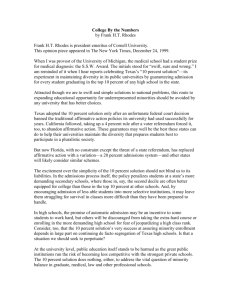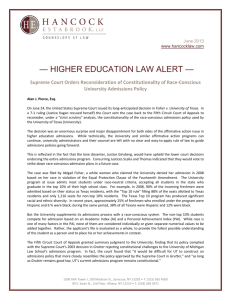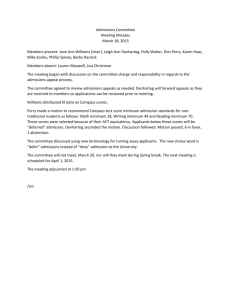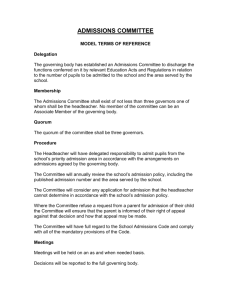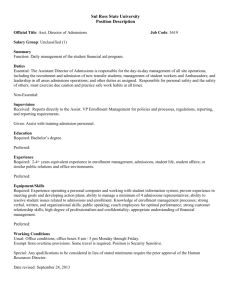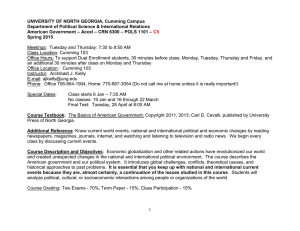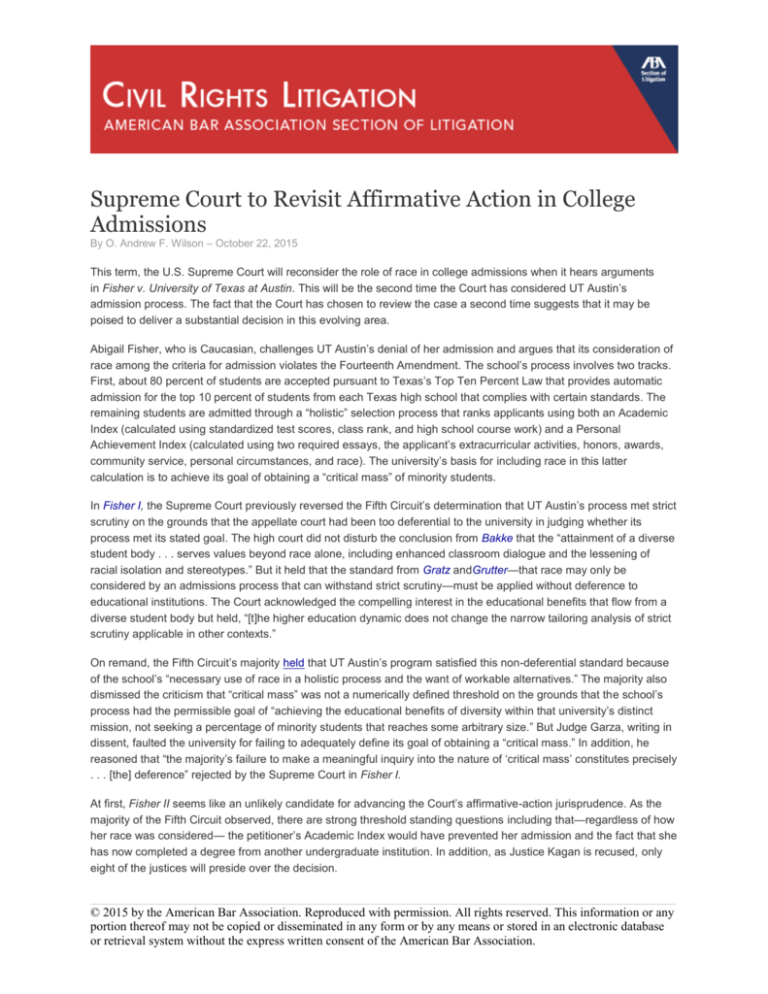
Supreme Court to Revisit Affirmative Action in College
Admissions
By O. Andrew F. Wilson – October 22, 2015
This term, the U.S. Supreme Court will reconsider the role of race in college admissions when it hears arguments
in Fisher v. University of Texas at Austin. This will be the second time the Court has considered UT Austin’s
admission process. The fact that the Court has chosen to review the case a second time suggests that it may be
poised to deliver a substantial decision in this evolving area.
Abigail Fisher, who is Caucasian, challenges UT Austin’s denial of her admission and argues that its consideration of
race among the criteria for admission violates the Fourteenth Amendment. The school’s process involves two tracks.
First, about 80 percent of students are accepted pursuant to Texas’s Top Ten Percent Law that provides automatic
admission for the top 10 percent of students from each Texas high school that complies with certain standards. The
remaining students are admitted through a “holistic” selection process that ranks applicants using both an Academic
Index (calculated using standardized test scores, class rank, and high school course work) and a Personal
Achievement Index (calculated using two required essays, the applicant’s extracurricular activities, honors, awards,
community service, personal circumstances, and race). The university’s basis for including race in this latter
calculation is to achieve its goal of obtaining a “critical mass” of minority students.
In Fisher I, the Supreme Court previously reversed the Fifth Circuit’s determination that UT Austin’s process met strict
scrutiny on the grounds that the appellate court had been too deferential to the university in judging whether its
process met its stated goal. The high court did not disturb the conclusion from Bakke that the “attainment of a diverse
student body . . . serves values beyond race alone, including enhanced classroom dialogue and the lessening of
racial isolation and stereotypes.” But it held that the standard from Gratz andGrutter—that race may only be
considered by an admissions process that can withstand strict scrutiny—must be applied without deference to
educational institutions. The Court acknowledged the compelling interest in the educational benefits that flow from a
diverse student body but held, “[t]he higher education dynamic does not change the narrow tailoring analysis of strict
scrutiny applicable in other contexts.”
On remand, the Fifth Circuit’s majority held that UT Austin’s program satisfied this non-deferential standard because
of the school’s “necessary use of race in a holistic process and the want of workable alternatives.” The majority also
dismissed the criticism that “critical mass” was not a numerically defined threshold on the grounds that the school’s
process had the permissible goal of “achieving the educational benefits of diversity within that university’s distinct
mission, not seeking a percentage of minority students that reaches some arbitrary size.” But Judge Garza, writing in
dissent, faulted the university for failing to adequately define its goal of obtaining a “critical mass.” In addition, he
reasoned that “the majority’s failure to make a meaningful inquiry into the nature of ‘critical mass’ constitutes precisely
. . . [the] deference” rejected by the Supreme Court in Fisher I.
At first, Fisher II seems like an unlikely candidate for advancing the Court’s affirmative-action jurisprudence. As the
majority of the Fifth Circuit observed, there are strong threshold standing questions including that—regardless of how
her race was considered— the petitioner’s Academic Index would have prevented her admission and the fact that she
has now completed a degree from another undergraduate institution. In addition, as Justice Kagan is recused, only
eight of the justices will preside over the decision.
_________________________________________________________________________________________________________
© 2015 by the American Bar Association. Reproduced with permission. All rights reserved. This information or any
portion thereof may not be copied or disseminated in any form or by any means or stored in an electronic database
or retrieval system without the express written consent of the American Bar Association.
Civil Rights Litigation
_________________________________________________________________________________________________________
Despite these issues, and its previous review, the fact that the Court has decided to revisitFisher this term portends a
more substantial decision on affirmative action. On one end of the spectrum, the Court could answer Judge Garza’s
critique and explain how universities should define racial objectives that satisfy non-deferential strict scrutiny. On the
other end, however, some commentators have speculated that a second review of UT Austin’s program—which the
Fifth Circuit described as “nearly indistinguishable from the University of Michigan Law School’s program in Grutter”—
signals a willingness to overrule Grutterentirely and reverse its holding that universities may consider race in
admissions as part of a holistic review process. Regardless of where the Court lands on this spectrum, the coming
decision promises a material development in the law on race and admissions under the Fourteenth Amendment.
Keywords: litigation, civil rights, race, affirmative action, 14th Amendment, college admissions
O. Andrew F. Wilson is a partner with Emery Celli Brinckerhoff & Abady LLP in New York, NY.
_________________________________________________________________________________________________________
© 2015 by the American Bar Association. Reproduced with permission. All rights reserved. This information or any
portion thereof may not be copied or disseminated in any form or by any means or stored in an electronic database
or retrieval system without the express written consent of the American Bar Association.

